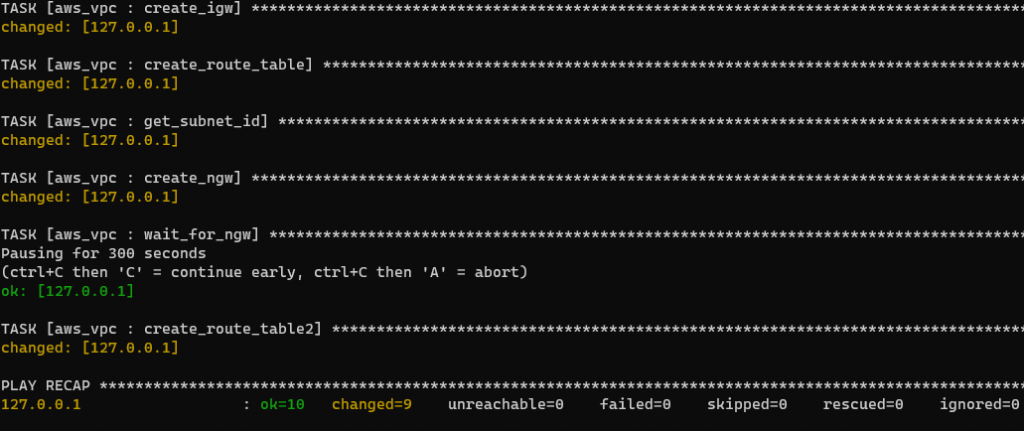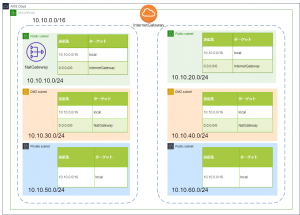I created an Ansible playbook to build a 3-layer network configuration on AWS

Hello.
This is Shimeji from the SS team.
I previously wrote an article about building a two-layer network with Ansible, but in actual projects, environments are often built with a three-layer network.
So, in Ansible, he created a playbook to build a three-tier AWS network.
*The actual environment to be built is here ↓

Directory structure
The directory structure of the playbook is as follows.
. ├── README.md ├── ansible.cfg ├── hosts ├── roles │ └── aws_vpc │ ├── tasks │ │ └── main.yml │ └── vars │ └── main. yml └── vpc_create.yml
Playbook
Yes, it's a playbook.
It's basically the same as the two-layer playbook, but we've added the ability to create a new NATGATEWAY and create a route table for the DMZ subnet.
--- # tasks file for aws_vpc - name: create_vpc ec2_vpc_net: name: "{{ vpc_name }}" cidr_block: "{{ vpc_cidr }}" region: "{{ region }}" profile: "{{ profile }}" dns_hostnames: yes dns_support: yes register: vpc_info # PUBLIC_SUBNET create - name: create_public_subnet ec2_vpc_subnet: vpc_id: "{{ vpc_info.vpc.id }}" cidr: "{{ item.pub_subnet_cidr }}" az: "{{ item.subnet_az }}" region: "{{ region }}" resource_tags: { "Name":"{{ item.pub_subnet_name }}" } profile: "{{ profile }}" register: pubsub_info with_items: - "{{ pub_subnet }} " # Create DMZ_SUBNET - name: create_dmz_subnet ec2_vpc_subnet: vpc_id: "{{ vpc_info.vpc.id }}" cidr: "{{ item.dmz_subnet_cidr }}" az: "{{ item.subnet_az }}" region: "{{ region }}" resource_tags: { "Name":"{{ item.dmz_subnet_name }}" } profile: "{{ profile }}" register: pubsub_info with_items: - "{{ dmz_subnet }}" # PRIVATE_SUBNET creation - name: create_private_subnet ec2_vpc_subnet: vpc_id: "{{ vpc_info.vpc.id }}" cidr: "{{ item.pri_subnet_cidr }}" az: "{{ item.subnet_az }}" region: "{{ region }}" resource_tags: { " Name":"{{ item.pri_subnet_name }}" } profile: "{{ profile }}" register: prisub_info with_items: - "{{ pri_subnet }}" # Create IGW - name: create_igw ec2_vpc_igw: vpc_id: "{{ vpc_info .vpc.id }}" region: "{{ region }}" tags: { "Name":"{{ igw_name }}" } profile: "{{ profile }}" register: igw_info # ROUTETABLE creation (IGW) - name: create_route_table ec2_vpc_route_table: vpc_id: "{{ vpc_info.vpc.id }}" subnets: "{{ atache_igw_subnet }}" routes: - dest: 0.0.0.0/0 gateway_id: "{{ igw_info.gateway_id }}" region: "{{ region }}" profile: "{{ profile }}" resource_tags: { "Name":"{{ rttable_pub_name }}" } # Get the SUBNETID to place the NGW - name: get_subnet_id shell: aws ec2 describe-subnets --region {{ region }} --profile {{ profile }} --output text | grep -B 1 {{ ngw_subnet_name }} | awk 'NR==1 {print $12}' register: ngw_subnet_id #- name: show # debug: # msg: "{{ ngw_subnet_id.stdout }}" # NGW creation - name: create_ngw ec2_vpc_nat_gateway: subnet_id: "{{ ngw_subnet_id.stdout }}" region: "{{ region }}" profile: "{{ profile }}" wait: yes register: ngw_info #- name: show # debug: # msg: "{{ ngw_info.nat_gateway_id }}" # Wait until NGW creation #- name: wait_for_ngw # pause: # minutes: 5 # ROUTETABLE creation ( NGW) - name: create_route_table2 ec2_vpc_route_table: vpc_id: "{{ vpc_info.vpc.id }}" subnets: "{{ atache_ngw_subnet }}" routes: - dest: 0.0.0.0/0 gateway_id: "{{ ngw_info.nat_gateway_id }} " region: "{{ region }}" profile: "{{ profile }}" resource_tags: { "Name":"{{ rttable_dmz_name }}" }
I format the results of the awscli command to get the ID of the DMZ subnet.
It's like using this to create NATGATEWAY.
Also, it takes a while for NATGATEWAY to be created, so I use the "pause" module to temporarily stop the process.
*Additional note:
Someone pointed out on Twitter that "ec2_vpc_nat_gateway" has an option called "wait"!
thank you!
Defining variables
--- # vars file for aws_vpc # REGION region: "ap-northeast-1" # PROFILE profile: "default" # VPC vpc_name: "shimeji-3layer-vpc" vpc_cidr: "10.10.0.0/16" # IGW igw_name: "shimeji-3layer-igw" # NGW ngw_name: "shimeji-3layer-ngw" # Subnet name to create NGW ngw_subnet_name: "shimeji-3layer-public-subnet-a" # ROUTETABLE(PUBLIC) rttable_pub_name: "shimeji-3layer- pub-rt" # ROUTETABLE(DMZ) rttable_dmz_name: "shimeji-3layer-dmz-rt" # PUBLIC_SUBNET pub_subnet: - { pub_subnet_cidr: "10.10.10.0/24" ,subnet_az: "ap-northeast-1a" ,pub_subnet_name: "shimeji -3layer-public-subnet-a" } - { pub_subnet_cidr: "10.10.20.0/24" ,subnet_az: "ap-northeast-1c" ,pub_subnet_name: "shimeji-3layer-public-subnet-c" } # DMZ_SUBNET dmz_subnet: - { dmz_subnet_cidr: "10.10.30.0/24" ,subnet_az: "ap-northeast-1a" ,dmz_subnet_name: "shimeji-3layer-dmz-subnet-a" } - { dmz_subnet_cidr: "10.10.40.0/24" ,subnet_az: "ap-northeast-1c" ,dmz_subnet_name: "shimeji-3layer-dmz-subnet-c" } # PRIVATE_SUBNET pri_subnet: - { pri_subnet_cidr: "10.10.50.0/24" ,subnet_az: "ap-northeast-1a" ,pri_subnet_name: "shimeji-3layer-private-subnet-a" } - { pri_subnet_cidr: "10.10.60.0/24" ,subnet_az: "ap-northeast-1c" ,pri_subnet_name: "shimeji-3layer-private-subnet-c" } # IGW Subnet linked to atache_igw_subnet: - "10.10.10.0/24" - "10.10.20.0/24" # Subnet linked to NGW atache_ngw_subnet: - "10.10.30.0/24" - "10.10.40.0/24"
This time, add the prefix "shimeji-3layer" to each resource.
execution
Let's try it out.
root@BYD-NPC-023:/opt/playbook/aws-vpc-3layer# ansible-playbook -i hosts vpc_create.yml PLAY [create vpc subnet igw routetable] ************** ************************************************** ************************************************** ************************************************** ***** TASK [aws_vpc : create_vpc] ************************************************** ************************************************** ************************************************** ************************************************** changed: [127.0.0.1] TASK [aws_vpc : create_public_subnet] **************************************************************** ************************************************** ************************************************** ************************** changed: [127.0.0.1] => (item={u'pub_subnet_name': u'shimeji-3layer- public-subnet-a', u'subnet_az': u'ap-northeast-1a', u'pub_subnet_cidr': u'10.10.10.0/24'}) changed: [127.0.0.1] => (item={u 'pub_subnet_name': u'shimeji-3layer-public-subnet-c', u'subnet_az': u'ap-northeast-1c', u'pub_subnet_cidr': u'10.10.20.0/24'}) TASK [aws_vpc: create_dmz_subnet] ************************************************ ************************************************** ************************************************** ************************** changed: [127.0.0.1] => (item={u'dmz_subnet_cidr': u'10.10.30.0/ 24', u'dmz_subnet_name': u'shimeji-3layer-dmz-subnet-a', u'subnet_az': u'ap-northeast-1a'}) changed: [127.0.0.1] => (item={u 'dmz_subnet_cidr': u'10.10.40.0/24', u'dmz_subnet_name': u'shimeji-3layer-dmz-subnet-c', u'subnet_az': u'ap-northeast-1c'}) TASK [aws_vpc: create_private_subnet] ************************************************ ************************************************** ************************************************** ********************** changed: [127.0.0.1] => (item={u'pri_subnet_cidr': u'10.10.50.0/24', u 'pri_subnet_name': u'shimeji-3layer-private-subnet-a', u'subnet_az': u'ap-northeast-1a'}) changed: [127.0.0.1] => (item={u'pri_subnet_cidr': u'10.10.60.0/24', u'pri_subnet_name': u'shimeji-3layer-private-subnet-c', u'subnet_az': u'ap-northeast-1c'}) TASK [aws_vpc : create_igw] ** ************************************************** ************************************************** ************************************************** ***************************** changed: [127.0.0.1] TASK [aws_vpc : create_route_table] ******** ************************************************** ************************************************** ************************************************** *************** changed: [127.0.0.1] TASK [aws_vpc : get_subnet_id] ********************** ************************************************** ************************************************** ************************************************** ****** changed: [127.0.0.1] TASK [aws_vpc : create_ngw] ************************************* ************************************************** ************************************************** ************************************************** changed: [127.0.0.1] TASK [aws_vpc : wait_for_ngw] ************************************************ ************************************************** ************************************************** ************************************************ Pausing for 300 seconds (ctrl+C then 'C' = continue early, ctrl+C then 'A' = abort) ok: [127.0.0.1] TASK [aws_vpc : create_route_table2] **************** ************************************************** ************************************************** ************************************************** *** changed: [127.0.0.1] PLAY RECAP ************************************** ************************************************** ************************************************** ************************************************** ********** 127.0.0.1 : ok=10 changed=9 unreachable=0 failed=0 skipped=0 rescued=0 ignored=0
Yes, it was a success!
At the end
It is possible to build an AWS network by clicking from the management screen, but it is time consuming and may lead to human error.
In that respect, using Ansible will save you time and reduce mistakes!
↓By the way, the second layer is here.

 0
0







